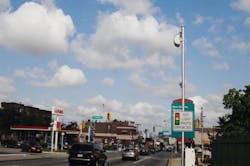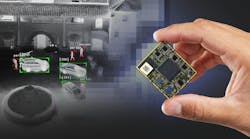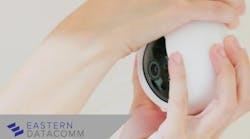While they may draw the ire of drivers across the nation, a new study conducted by John Dunham and Associates on behalf of American Traffic Solutions has found that red-light safety cameras provide substantial cost savings to cities in the long run in terms of reduced number of accidents and the manpower required in responding to them.
The study projected estimated cost savings over a five-year period based upon the deployment of just one red-light camera at a busy intersection in 25,000 cities and towns across the U.S. According to the methodology, cost was calculated using the $57,000 annual fixed fee cities pay ATS, which installs and maintains red-light safety cameras across the nation, for one camera, while savings were based solely on reduction in traffic crashes and salary costs associated with redeploying officers from patrol work to traffic enforcement. Revenues from traffic citations were not factored into the study.
Estimated savings varied depending on the city. In Atlanta, for example, the study found that from 2011 to 2015, the city would save nearly $700,000 from the use of just one red-light safety camera. However, Linden, N.J., was projected to save more than $1.3 million during that same time period. Click here to see the estimated savings for your city. For the 195 cities and towns using red-light safety cameras from ATS, the study showed one camera at one intersection saves on average $190,415 in avoided crash and redeployment costs in one year, resulting in a combined yearly savings of more than $37 million.
"I think it’s important that drivers recognize the economic costs that society incurs as a result of red-light running-related collisions," said Charles Territo, vice president of communications for ATS. "Traffic-related injuries and fatalities are a significant drain on our economy, not to mention the loss of life and the pain and suffering that accompany them. This study attempts to quantify the savings a community can expect from its dollar in the cameras, outside of any revenue that may or may not be generated."
Though the estimated cost savings in the study drop each year, Territo said that was done to account for the expected decrease in the number of collisions. "This model attempts to simulate the types of reductions that have been found to occur when red-light cameras are installed."
While some may argue that red-light running is not a problem, Territo said that the facts tell another story. According to the National Highway Transportation Safety Administration, red-light running crashes were the cause of 762 deaths in 2008. The NHTSA estimates that 165,000 people are injured annually by drivers running red-lights.
"Each state is entitled to its own decisions about how best to equip law enforcement. I think this study provides another analysis that can be used in determining the benefits that installing cameras can provide," Territo added. "Red-light safety cameras allow law enforcement to do more with less. In addition to reducing the number of collisions, injuries and fatalities, they also allow law enforcement to continue to monitor dangerous intersections, 24 hours a day, seven days a week, without having to deploy manpower and already scarce resources to that type of enforcement."
Despite the outrage that many people express over these cameras as being merely tools for revenue generation, Territo said that the consequences for drivers caught running red-lights in many states are not as great as they are perceived to be and that the cost benefit of preventing accidents far outweighs the financial gain of issuing citations.
"Unlike an officer-issued violation, in most states, red-light safety cameras carry no (driver’s license) points and have no impact on an individual’s insurance," Territo explained. "Additionally, unlike officer-issued violations, red-light safety camera violations come with a 12-second video that allows the individual to review the violation and decide whether or not to contest it. Roughly 75 percent of the events captured by red-light safety cameras are actually dismissed prior to being issued during the review process."
Territo said that that there are also indirect benefits to having red-light cameras, such as being able to call up video footage for the investigation of other crimes.
"There isn’t a day that goes by where one of our customers doesn’t request video from a red-light safety camera location to help solve additional crimes," he said. "Whether those (incidents) are something as simple as a hit-and-run or something as complex as a carjacking, these cameras assist law enforcement every day."
Territo said that ATS has received an average or 1,500 requests a year over the last two years for video footage from a red-light camera location.
"Just the other day, we were asked for video that was used to capture someone who hit a bicyclist in Murfreesboro, Tennessee. A few months ago, our video was used to help break a horse-rustling ring in Polk County, Florida," he added. "Our video has been used to help solve murders, assaults, kidnappings, drive-by shootings, burglaries and several other crimes."


